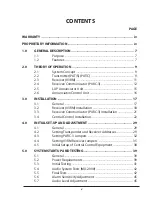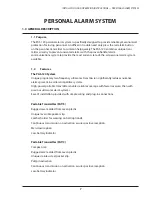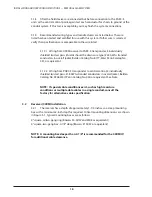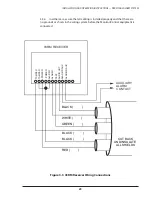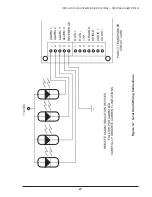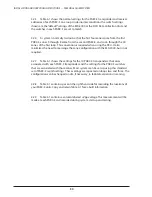
17
INSTALLATION AND OPERATION INSTRUCTIONS — PERSONAL ALARM SYSTEM
3.0
INSTALLATION
3.1
General
3.1.1
This section covers the installation of the PAS-120 system. The section assumes
that you have reviewed the General Description and Theory of Operation sections and
have studied the PAS Design Guide.
3.1.2
Installation of the PAS-120 system requires no special equipment. Standard
wire installation tools can be used. Additional tools required are the standard hand
tools used during any similar electronic system installation.
3.1.3
You will need a high quality digital volt-ohmmeter, preferably battery
operated. This meter will be used for all measurements and adjustments. A good
quality oscilloscope (15 MHz or faster) will be of help if troubleshooting is required.
NOTE: If you have never installed a PAS-120 system before, it is
recommended that you connect the system in your shop and familiarize
yourself with the adjustment and operation before attempting any
installation in the field.
3.1.4
Particular attention should be paid to the installation of the wiring system
because many problems occurring after installation are traced to the incorrect type or
installation of wiring.
3.1.5
All wiring must be installed in accordance with the latest edition of the
National Electrical Code. Wiring should be installed in conduit whenever possible. The
personal alarm system wiring should be separated from the wiring of all other systems.
If the personal alarm system wiring must be installed in the same conduit with the
wiring of another system, consult the factory for additional precautionary information.
3.1.6
A conductor or wire shield that touches another wire or the conduit system
can disrupt the entire system. More importantly, this type of defect is often the origin
of intermittent trouble signals that are very time consuming and expensive to fix.
3.1.7
During installation, all wiring should be tested for grounding and shorts. After
wiring installation but before equipment is connected, check each conductor for
shorts between conductors and connections to ground. This includes ALL shields. You
may think that this is time consuming, but it is nothing compared to the time you may
have to spend finding a bad cable.



